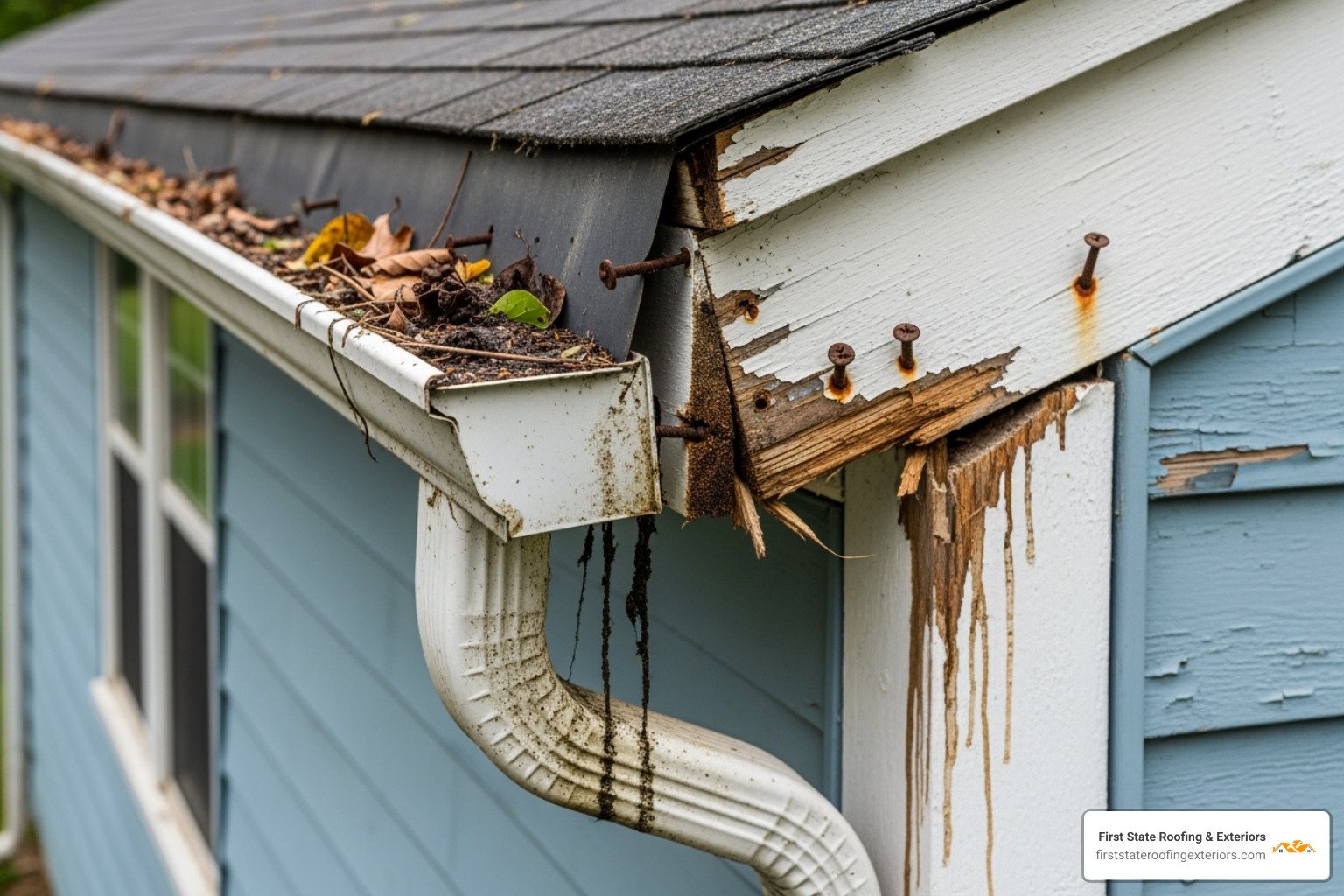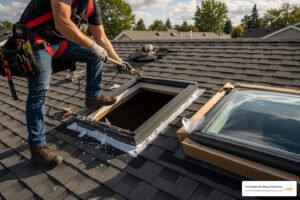Why Your Gutters Are Crying for Help (And How to Answer the Call)
Sagging gutter repair is a common but critical home maintenance task for Delaware homeowners. When gutters droop or pull away from your home, they’re signaling a problem that needs immediate attention to prevent costly water damage. Ignoring them can lead to issues with your foundation, siding, and landscaping, with repairs costing thousands.
Quick Fix Guide for Sagging Gutters:
- Clean debris from gutters and downspouts
- Tighten loose hangers or replace damaged ones
- Adjust the slope to 1/4 inch per 10 feet toward downspouts
- Add extra support with additional hangers spaced 2 feet apart
- Replace damaged sections if beyond repair
Your gutters are essential for channeling water away from your home. When they sag, this protection fails, allowing water to pool around your foundation or seep into your basement. At First State Roofing & Exteriors, we’ve helped countless Delaware homeowners tackle these issues before they become expensive disasters.
With over 20 years of hands-on experience, our team has seen how proper sagging gutter repair can save homeowners thousands in water damage costs. We’ve guided local families through everything from simple hanger replacements to complete gutter system overhauls.
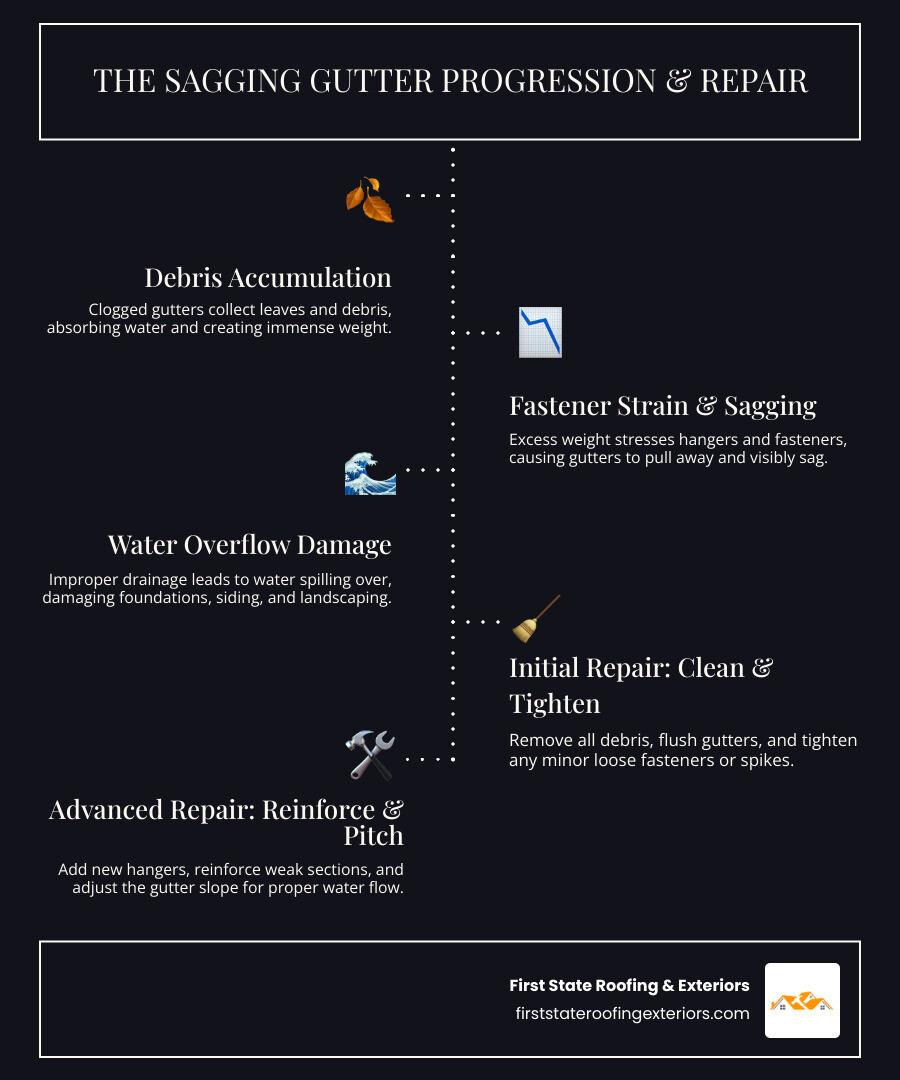
Why Gutters Sag: Common Causes and Telltale Signs
Understanding why sagging gutter repair becomes necessary can help you spot problems early. Gutters sag for several common reasons:
- Debris Buildup: Leaves and twigs soak up water, adding immense weight. A 20-foot section of clogged gutter can weigh around 200 pounds, causing it to droop.
- Loose Fasteners: Over time, screws and hangers can rust, loosen from temperature changes, or fail under the weight of water.
- Improper Installation: If hangers are spaced too far apart (more than 2-3 feet) or the slope is incorrect, the system is set up for failure.
- Weather Damage: In Delaware, heavy snow, strong winds, and especially ice dams can bend or tear gutters from the house.
- Aging Materials & Fascia Rot: Gutter materials weaken over decades. More critically, the fascia board they attach to can rot from moisture, preventing fasteners from holding securely.
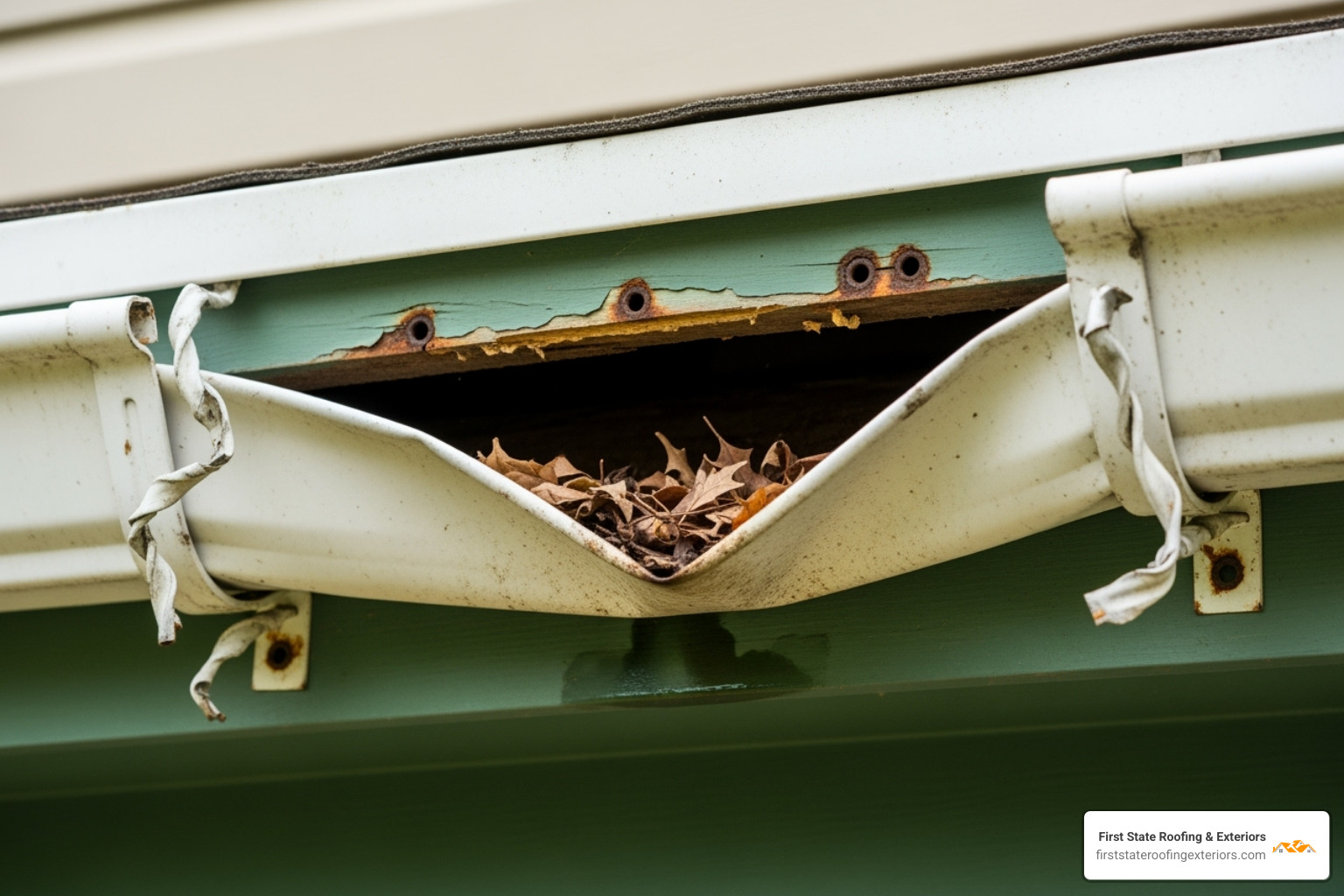
Signs Your Gutters Need Attention
Your gutters will show clear signs when they need help. Look for:
- Visible Dips or Bends: The gutter line should be straight, not wavy.
- Gaps Between Gutter and Fascia: Daylight between the gutter and your house means fasteners are failing.
- Water Overflowing the Sides: During rain, water should flow to downspouts, not spill over the edges.
- Peeling Paint or Water Stains: Stains on siding or under the eaves indicate water is escaping where it shouldn’t.
- Pooling Water or Soil Erosion: Water collecting near your foundation or washed-out landscaping are red flags.
The Importance of Proper Gutter Slope
Gutters require a slight gutter pitch to function correctly—they aren’t meant to be perfectly level. The standard is a slope of 1/4 inch for every 10 feet toward the downspouts. This incline uses gravity to keep water moving.
Without the right slope, standing water becomes a major issue. It adds weight, breeds mosquitoes, and accelerates rust and deterioration. Checking and correcting the slope is a key part of any sagging gutter repair project, ensuring your gutters effectively protect your home. For more technical details, this guide on proper gutter slope is a great resource.
Gearing Up for the Fix: Essential Tools and Safety Precautions
Before starting your sagging gutter repair, gathering the right tools and prioritizing safety is essential. For most repairs, you’ll need basic equipment:
- Safety Gear: A sturdy extension ladder, work gloves, and safety goggles.
- Tools: A power drill, hammer, pry bar, measuring tape, and a level (a string level is great for long sections).
- Materials: High-quality gutter sealant and new gutter hangers or screws.

Ladder Safety is Non-Negotiable
Gutter work involves heights, making ladder safety paramount. Always follow these rules:
- Place your ladder on stable, level ground. Use levelers if needed.
- Maintain three points of contact at all times (two feet and one hand, or two hands and one foot).
- Don’t overreach. Move the ladder frequently instead of stretching.
- Work with a spotter to hold the ladder steady and assist you.
For detailed guidelines, review OSHA’s official resources.
Choosing the Right Fasteners
Using the right fasteners ensures a lasting repair. Here are your main options:
- Threaded Gutter Spikes: An upgrade from old smooth nails, these grip the fascia board better. They use a ferrule (a metal sleeve) to prevent crushing the gutter.
- Hidden Hangers: The modern standard. They clip inside the gutter and screw into the fascia, providing strong, invisible support.
- Gutter Screws: Offer excellent holding power and are less likely to loosen over time than spikes.
- Brackets: Provide strong external support but are visible from the ground.
When replacing fasteners, drill new pilot holes for a secure grip. For professional-grade solutions and expert installation, explore our Gutter Repair services.
A Homeowner’s Guide to Sagging Gutter Repair
With your tools and safety plan, you’re ready to tackle that sagging gutter repair. Most homeowners can handle these repairs with patience by following a step-by-step approach. Knowing when to call a professional for complex issues is also a smart move.
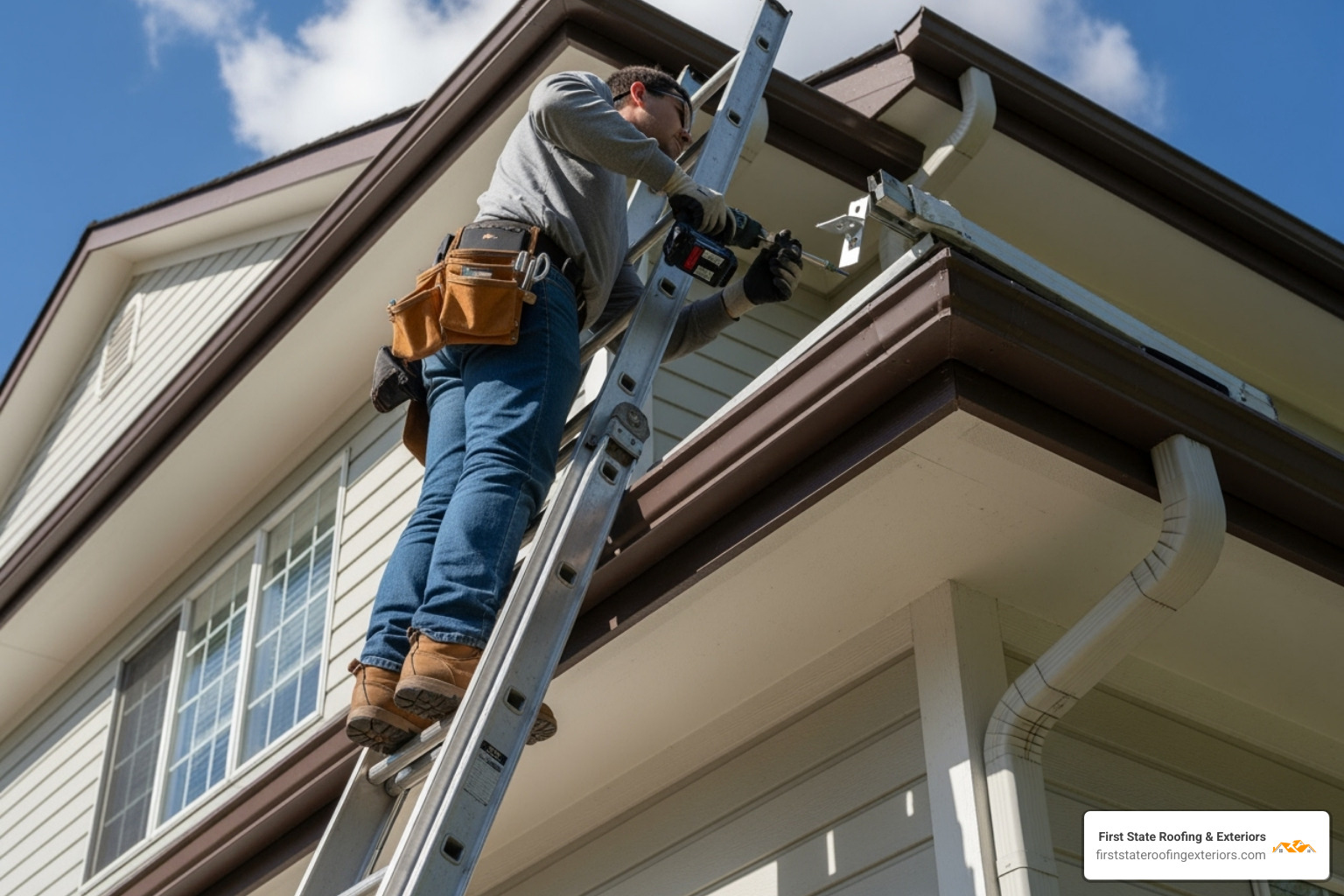
Step 1: Clean and Inspect the Gutters
First, you need to diagnose the problem. Start by thoroughly cleaning the gutters.
- Remove leaves and debris by hand, placing waste in a bucket.
- Flush with a hose, starting from the end farthest from the downspout. This reveals leaks, pooling water, and slow flow.
- Check for clogs in downspouts. If water backs up, you have a clog that may require a plumber’s snake to clear.
- Identify sagging sections and inspect for cracks, holes, or rust now that the gutters are clean.
Step 2: Simple Fixes for Minor Sagging Gutter Repair
Many issues can be solved with basic reinforcement.
- Tighten loose spikes by tapping them back in with a hammer. If they don’t hold, they need to be replaced.
- Replace old spikes with screws for a much more secure, long-term hold. Pry out the old spike and drive in a new threaded gutter screw.
- Add new hidden hangers for extra support. The golden rule is to have hangers spaced every 2 feet, especially in areas with heavy snow.
- Seal minor leaks with a high-quality gutter sealant after cleaning and drying the area.
Step 3: Tackling Severe Damage and Adjusting Slope
For more serious sagging gutter repair, you may need to re-hang entire sections.
- Remove old hangers carefully with a pry bar or drill.
- Patch old screw holes with weatherproof caulk to prevent water from seeping into the fascia.
- Re-hang the gutter section with a helper. Use new, high-quality fasteners like hidden hangers or gutter screws.
- Use a level and string line to set the correct slope. The gutter must drop 1/4 inch per 10 feet toward the downspout. This step is crucial to prevent water from pooling.
If you find extensive fascia rot, it’s time to call a professional. Damaged fascia must be repaired before new gutters can be securely installed. For comprehensive exterior maintenance, consider our Siding Exterior Maintenance services.
Repair or Replace? Making the Smart Choice for Your Gutters
When facing gutter issues, you must decide whether to repair or replace. While sagging gutter repair is cost-effective for minor problems, replacement is sometimes the smarter long-term investment.
Choose repair for:
- A few loose fasteners or small leaks.
- Isolated sagging in one or two sections.
- Gutters that are relatively new (less than 15 years old) and otherwise in good condition.
Consider replacement when:
- You have widespread sagging, rust, or multiple large cracks and holes.
- Your gutters are old (15+ years) or made of a material like thin vinyl that constantly fails.
- You are facing frequent, recurring repair costs.
Failing gutters can cause thousands in foundation or siding damage, often making the cost of a new system more economical than repeated patch-ups. If you’re constantly fixing problems, your gutter system is likely failing as a whole.
When Replacement is the Best Option
Certain signs clearly indicate that replacement is necessary:
- Severe Fascia Rot: If the wood behind the gutter is soft or crumbling, new fasteners won’t hold. The fascia must be replaced, making it the perfect time for new gutters.
- Multiple Large Cracks or Holes: This signals that the gutter material itself is breaking down.
- Bent or Warped Sections: Gutters damaged by ice or storms rarely regain their shape and will continue to cause overflow issues.
- Outdated Sectional Systems: Gutters with seams every 10 feet are prone to leaks. Modern seamless systems are a far more reliable alternative.
When replacement is the right call, our team can help. Learn more about our professional Gutter Installation services.
Frequently Asked Questions about Sagging Gutter Repair
Homeowners often have questions about sagging gutter repair. Here are answers to some of the most common ones we hear from Delaware families.
How do you fix standing water in gutters?
Standing water is usually caused by an improper slope or a clog. First, ensure your gutters are completely clean. Then, use a level to check the slope. Gutters must drop at least 1/4 inch for every 10 feet toward the downspout. If the pitch is wrong, you’ll need to adjust the hangers to correct it. This involves loosening the fasteners, repositioning the gutter section to the correct slope, and re-tightening everything.
Can I repair sagging gutters myself, or should I hire a professional?
This depends on the job’s scope and your comfort level. DIY is a good option for minor repairs like tightening a few hangers or sealing a small leak. However, you should hire a professional if you are uncomfortable on a ladder, the roof is high, or you’re dealing with extensive damage. Issues like rotted fascia boards, widespread sagging, or re-pitching an entire system require professional expertise to ensure the job is done safely and correctly.
How can I prevent my gutters from sagging in the future?
Prevention relies on regular maintenance. Follow these tips to keep your gutters in top shape:
- Clean your gutters at least twice a year to prevent heavy debris buildup.
- Inspect hangers and fasteners during cleaning and tighten any loose ones.
- Consider gutter guards to significantly reduce the frequency of cleanings.
- Address ice dams quickly in winter, as the weight of ice can bend or pull gutters off the house.
- Ensure downspouts extend several feet from your foundation to protect it from water damage.
Conclusion: Get Your Gutters Back in Shape for Good
Proper gutter maintenance is essential for protecting your home. This guide has covered the key aspects of sagging gutter repair, from identifying causes to performing the fixes. Many homeowners can handle minor repairs like tightening hangers or sealing small leaks with the right tools and safety measures.
However, it’s crucial to recognize when a job requires professional help. For extensive damage, fascia rot, or if you’re uncomfortable working at heights, calling an expert is the safest and most effective choice. A professional repair ensures a lasting solution that protects your investment.
For Delaware homeowners in Milford and surrounding areas, First State Roofing & Exteriors offers decades of local expertise. We understand the challenges of our climate and are dedicated to providing reliable, long-lasting gutter solutions.
Don’t let sagging gutters lead to costly water damage. We believe in transparency and offer free, no-obligation estimates to help you understand your options without any pressure.
Ready to get your gutters back in fighting shape? Call us today at (302) 222-4065 to schedule your free inspection. Our team will assess your gutters and help you make the best decision for your home and budget.
